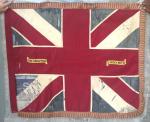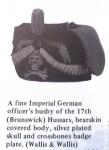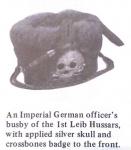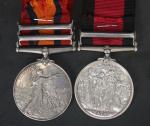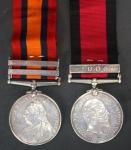-
Posts
13,225 -
Joined
-
Last visited
-
Days Won
22
Content Type
Profiles
Forums
Blogs
Gallery
Events
Store
Everything posted by Mervyn Mitton
-
With so many 'new' Countries being created - particularly in Africa - it is always a problem to have new flags, medals and awards. Usually they follow the politics of the new Govt. and commemorate some strange idealistic subjects in poorly made design. The exception to this was Rhodesia. When U.D.I. (Unilateral Declaration of Independence - the decision to have Independence with only one party agreeing) was declared in 1965, they had the same problem of creating new names, Institutions, flags and also, medals and awards. However, you must remember that the decision to 'break' links was really the fault of a very intransigent British Govt. - under Harold Wilson. The approx. 250,000 white population were mostly of British descent and had fought strongly in both World Wars. They did not want their link with Britain forgotten and so most of the changes were not 'new' ideas but, rather revisions on the old familiar ways. Medals and Awards, therefore, followed the pattern of the established order - just with changes to design. The Order of the British Empire has always been a convenient way to reward both Military and Civilians - with different grades to cover most eventualities. The Rhodesian Govt. decided to follow this tried and trusted scheme and set-up the Rhodesian Legion of Merit. They were given out with extreme caution in order to protect the esteem in which they were held. The different grades followed the British system - coming down from the very top ones to a Commander of the Legion of Merit - and an Officer of the LM - and, finally a Member. An M.L.M. (Member of the Legion of Merit) was the direct equivalent of an M.B.E. - carried the right to have the initials following the name and was worn as a breast decoration. The period of U.D.I. only lasted until 1980. Mainly economic problems and the small population were responsible - but, one cannot overlook the treachery of the British Govt. who were determined to hand the Country to political activists. The result can be clearly seen today in the state of Zimbabwe. During this 15 year period there was a continuing war against terrorism - but, only 300 MLM's to civilians were awarded and 55 to the Military. This makes the award one of the rarer and most sought after for collectors.
-
Hi - Brian. I think most Forum members don't like to see medals polished - however, the badge is different and must look very good with the sheen of the silver against the gilt. Perhaps you could show another picture ? Your dating is obviously accurate, but you can see the start of the more elongated sides that became very prominent for Wm.4th. and Queen Victoria. You look to have a good collection and we must hope you will continue posting. Mervyn
-

What does E.A.A.W. Mean
Mervyn Mitton replied to azyeoman's topic in Great Britain: Orders, Gallantry, Campaign Medals
'Air Wing' has possibilities - the Rhodesian Air Force called their reserve units an air wing. However, now that you have mentioned his WW2 entitlement, there has to be the possibility of a labour battalion. We had such named units in Sth. Africa and it is a fact of life, that at that time many units of indigenous people were formed to provide ready labour. Could it be something along the lines of - 'Army Workforce'? -
Megan - there is a styalised Protea flower as part of the suspender.
-
Brian - this is a lovely example - and personally, it wouldn't worry me that it had a brooch conversion. I am a little curious about the silver coat of arms - the look in the photo is almost a pewter colour. This would be unusual as I would expect silver - perhaps it it the mellowing of the silver with age ? What do you think ? ps. Sorry to query your 1822 date - I would have thought more the Crown shape for William 4th.(1830-37) - certainly a little more angular then most Georgian ones. I'm not being 'picky' - just interested regarding a lovely old item ?
-

Collar Rank Insignia
Mervyn Mitton replied to sbintayab's topic in Great Britain: Militaria: Badges, Uniforms & Equipment
Brian - welcome to the Forum. I was interested to see the first pattern Infantry tunic - the Metropolitan Police also changed from the swallow tailed coatee at about the same time. They followed the current German pattern - and as with your example, the first ones were longer in the body. The next modifications shortened the tunic to about the present style. The Police had always worn their numbers on the raised collar - which in itself was a remainder from the period when the cult of 'Thuggees' had spread from India. The 'Thugs' would throw a silk handkerchief - with a heavy object tied at one end - around the throat of the victim and then strangle him. The first Police in 1829 had a 4" stock in leather (10cm) to prevent this. With the new tunic the numbers continued on the collar - but officers followed the Army style and had their ranks also on the collars. -
Muckaroon - congratulations on a great collection of old rifles - and you keep them very well. I often see old bayonets, so will keep an eye open and let you know if anything comes-in.
-
Very nice condition. When I did my Nat. Service in Australia they were still current issue - 9lbs 4 ozs - I shall never forget that weight - particularly on route marches...........
-
This incredible item was brought into me on Christmas Eve by a chap who had brought it from Rhodesia. (Zimbabwe). His Father had been resident in Rhodesia and also served in the S.A. Army. Amongst his late Father's possessions was this Regimental Colour - with Battle Honours for East Africa - 1916-1917. We have no idea which Regt. held the Colour - or, what happened to them. The chances are that they were raised to fight in SWA or, East Africa - continued with this Colour until 1918 - and were then disbanded. They could have been Rhodesian, Sth. African or, East African. Colours are usually hung in Churches - where the silk disintegrates and then they are encased in netting. This is how this one has been preserved. Private collections do NOT have Colours , they are regarded as too precious - however, I would like to see this one go to a home where it will be preserved and honoured. I will ensure that the price allows this. Should anyone have an interest in a WW1 Colour - please IM me. You all know that I do not sell from our Forum - however, this needs to find the right 'home'. p.s. The lettering that shows through is where the silk has gone. I only have a photo of one side - will add more if anyone is interested. You will see from the sewn standard holder on the left, that it was carried in ceremonies. Size wise - the two hands on the top corners will give an indication. I look forward to your comments - and, any help you can offer with identification.
-
Robin - I was looking through a ref. book for possible quiz questions and found these three examples of German Regt's. with skull and crossbones. I also found this postcard for the 17th in the back of my diary - we used to have the 1880 pattern horse blanket ornament in the shop. Hope they are useful to the thread.
-

british bar or irish bar?!
Mervyn Mitton replied to paddywhack's topic in Great Britain: Orders, Gallantry, Campaign Medals
The Gordon Riots of 1780 - which caused great damage in London and ended with the troops opening fire - led to the formation in 1786 of the Dublin Police Act. Three Commissioners were appointed, together with a paid force of Constables. The Act was interesting in that it was the first time in history that the word 'Police' and not 'Constabulary' was used. Timo - I'm not sure what point you are arguing - until 1922 Ireland was a British possession - under special Acts of Parliament. Your Bar is British. p.s. We must welcome Heritage to GMIC. -

Christmas present from my son
Mervyn Mitton replied to speagle's topic in Police Forces of the World
Hi - Ed - and the Compliments of the Season to you and your family. I was trying to work this nice badge out. Am I right in assuming it is for the Washington Police and that the Auxiliaries would be a 'back-up' Force - like the British Specials ? How old do you think it is ? -

british bar or irish bar?!
Mervyn Mitton replied to paddywhack's topic in Great Britain: Orders, Gallantry, Campaign Medals
Ireland split in 1922 - so most certainly he was British at that time. -
The Queen's South Africa Medal for the 2nd. Boer War is quite straightforward. There are Bars for 1901 and 1902 - so he obviously didn't do much to help the war effort ! Good Regiment though - Pte. H.R. Manning 3 D.Gds - (3rd. Dragoon Guards) - they were a Regt. of heavy Cavalry. The 1906 is much rarer - and although I'm sure it has been shown many times before on the Forum - it is an interesting medal. Firstly, it is the only Imperial medal to have been awarded from London for a local engagement and one in which no Imperial troops took part. Secondly, the numbers are small. Only 8000 with the bar ' 1906 ' and just 2000 with no bar. (They never crossed the Tugela River into Zululand) The King's head is that of Edward 7th, whilst the reverse shows the figure of 'NATAL' - She is holding a sword of justice - and in the other hand the Palm Branch of Peace. She is standing on a heap of Zulu weaponry. Brittania supports Her - with the Orb - representing Empire. The Sun - coming out from behind the clouds of 'Trouble' represents the future. All very symbolic ! The Anglo-Zulu War of 1879 saw the overthrow of the Zulu Nation and in fact Sir Garnet Wollesly - who took over from Lord Chelmsford - split the original Kingdom into a number of lesser ones. These didn't last long and things 'limped' along until 1906. The Natal Govt. introduced a Poll Tax - which was used as medium to stir up trouble amongst the Zulus. Since their defeat there had been several attempts at revolt - but, this tax gave the needed impetus. A chief - Bambatha - was working in collusion with the King at the time - Dinizulu - meetings were held, groups formed and it started with an attack on a Natal Police escort for people being evacuated. Natal was not in the weak condition it had been at the start of the Boer War and was able to assemble a substantial force to face the threat. This was also re-inforced by troops from the Transvaal. I will not go into all of the details - it is worth the trouble though to read how we were prepared to defend ourselves in difficult times. Eventually Bambatha was cornered and killed in the fight - the King, Dinizulu , was tried and exiled for a number of years to St. Helena. The 1906 medal is named to Tpr. H.R.Manning Ntl POLICE (Natal Police ) Since they were heavily involved it makes the pair more interesting. I was planning to do some research on his role in the Natal Police - unfortunately it was put out on Friday and someone bought-it on Sat. morning - so. I have lost my opportunity...




